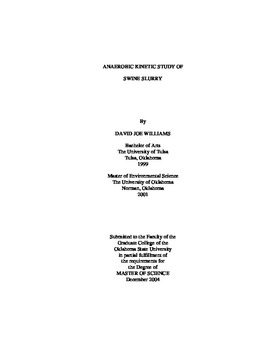| dc.contributor.author | Williams, David J. | |
| dc.date.accessioned | 2014-04-17T19:56:45Z | |
| dc.date.available | 2014-04-17T19:56:45Z | |
| dc.date.issued | 2004-12-01 | |
| dc.identifier.uri | https://hdl.handle.net/11244/10174 | |
| dc.description.abstract | The purpose of this study was to measure the anaerobic kinetic properties of diluted swine slurry. Anaerobic kinetic rates, particularly volatile fatty acid (VFA) consumption and biogas (CH4 and CO2) production were measured in a short-term study conducted at 20C and 35C. An initial study was conducted using swine slurry diluted to total solids loadings of 0.25%, 0.50%, and 0.75%, respectively. In order to ensure microbiological activity, a second study was conducted with the addition of anaerobic seed sludge. Adjusted total solids loadings were 0.33%, 0.55%, and 0.76%, respectively. The duration of the unseeded study was 28 days, and the duration of the seeded study was 42 days. Kinetic rates were measured as design considerations for an anaerobic sequencing batch reactor (ASBR). Due to prolonged storage, microbiological populations were dormant in the unseeded slurry. With the addition of anaerobic seed sludge, appreciable kinetic results were recorded. Slurry at both 20C as well as 35C exhibited significant VFA consumption and biogas production. The largest biogas volumes were produced by the 35C, 0.76% TS slurry, with a cumulative biogas production of 237.5mL. All reactors operated at 35C produced biogas volumes in excess of 100mL. Reactors operated at 20C produced biogas more slowly. Maximum daily biogas production had peaked during the second week of the trial for the 35C reactors. Peak production was ongoing during the sixth week the final week of the short-term study with reactors operated at 20C. VFA consumption was most significant for the 35C slurry. VFA concentrations decreased by approximately 3,000mg/L for the 35C, 0.76% TS slurry. Based on the kinetic rates observed at 20C and 35C, it is estimated that slurry substrate in a reactor with an operational temperature of 20C will require a solids retention time (SRT) twice as long as the SRT at 35C. In terms of reactor design, a longer SRT will generate a longer treatment interval, thus providing less frequent sludge wasting. | |
| dc.format | application/pdf | |
| dc.language | en_US | |
| dc.publisher | Oklahoma State University | |
| dc.rights | Copyright is held by the author who has granted the Oklahoma State University Library the non-exclusive right to share this material in its institutional repository. Contact Digital Library Services at lib-dls@okstate.edu or 405-744-9161 for the permission policy on the use, reproduction or distribution of this material. | |
| dc.title | Anaerobic Kinetic Study of Swine Slurry | |
| dc.type | text | |
| osu.filename | Williams_okstate_0664M_1126.pdf | |
| osu.college | Engineering, Architecture, and Technology | |
| osu.accesstype | Open Access | |
| dc.description.department | School of Civil & Environmental Engineering | |
| dc.type.genre | Thesis | |
| dc.subject.keywords | anaerobic | |
| dc.subject.keywords | swine | |
| dc.subject.keywords | methane | |
